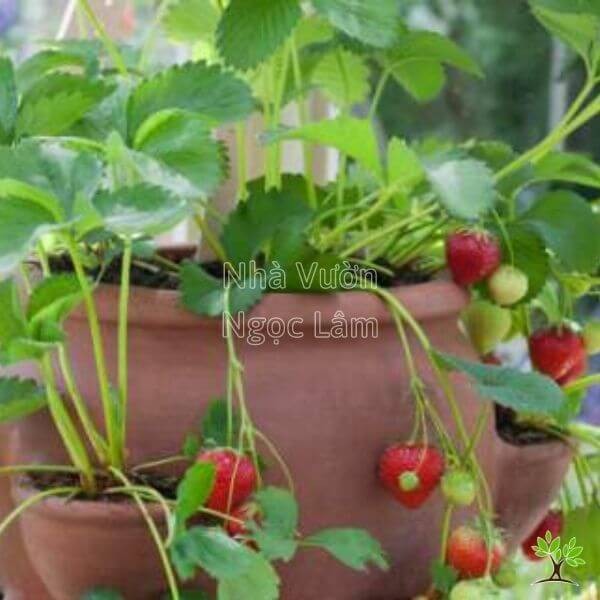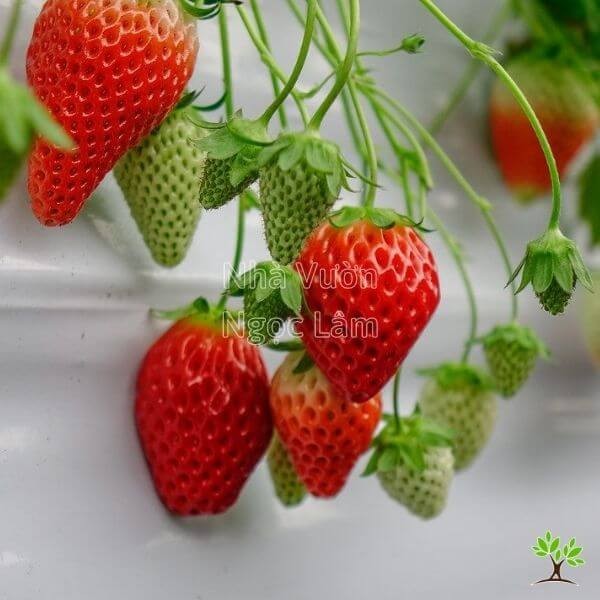No products in the cart.
NEWS
Master Strawberry Growing: Harvest Juicy Fruits in 3 Months
Strawberries are a beloved fruit, cherished for their sweet flavor, soft leaves, and charming berries. Their popularity as a home garden crop continues to grow. For those in regions with distinct seasons or less than ideal temperate climates, understanding the specific techniques needed to get plants fruiting quickly, perhaps within three months of planting, is key to success. This guide, drawing on horticultural expertise, will walk you through the essential steps for cultivating healthy strawberry plants and enjoying a rapid harvest.
A Brief Look at the Strawberry Plant
Strawberries belong to the Fragaria genus, often called garden strawberry or simply strawberry. They are flowering plants in the Rosaceae family (the rose family) and are herbaceous perennials. Originating primarily from the Americas, the common garden strawberry we know today was largely developed through European breeding in the 18th century.
 strawberry-fruit-ripe
strawberry-fruit-ripe
While strawberries thrive in temperate climates, they can be successfully grown in many other regions with careful management. Interestingly, the fleshy part of the strawberry isn’t botanically a true fruit; it’s an enlarged receptacle tissue from the flower. The actual fruits are the tiny seeds (achenes) embedded on the surface. The young fruit is typically green-white, turning vibrant red as it ripens.
Botanical Characteristics
 planting-strawberry-seedlings
planting-strawberry-seedlings
- Stem: Strawberries are herbaceous perennials with a short stem (crown) where leaves cluster closely. Axillary buds develop from the leaf axils and can grow into branch stems, runners (stolons), or flower stalks.
- Leaves: Leaf shape, structure, thickness, and hairiness vary by variety. Most strawberries have compound leaves with three leaflets, though some have four or five. Leaf edges are serrated. Leaf stalks are long, often turning reddish from white as they mature, indicating soil contact or maturity.
- Flowers: Each branch typically bears one flower cluster. Strawberry flowers are usually white, slightly rounded with five delicate petals. They are hermaphroditic, containing both stamens (male parts, around 25-30) and pistils (female parts, around 50-500) on each flower.
- Fruit: The strawberry fruit is technically a “false fruit,” formed from the enlarged flower receptacle, with the true fruits being the seeds on its surface. The fruit is oval-shaped, green when young, turning pink or red depending on the variety when ripe. They are sweet yet slightly tart and have a characteristic aroma.
- Roots: Strawberry plants have a fibrous root system that typically penetrates the soil up to about 30cm (approx. 12 inches) deep.
Ideal Conditions for Strawberry Growth
 watering-strawberry-plants
watering-strawberry-plants
Achieving successful strawberry harvests, especially a quick turnaround, depends heavily on providing the right environment.
Climate Conditions
Strawberries prefer cool temperatures, with an optimal range for vegetative growth and fruit development between 18 – 22°C (64 – 72°F). A significant temperature difference between day and night is particularly beneficial for increasing fruit set and yield.
Strawberries are sun-loving plants. Abundant sunlight promotes vigorous growth and development. Insufficient light can negatively impact flowering and fruit set.
Soil Requirements
Strawberries thrive in light, loamy soil that is rich in nutrients and organic matter. The soil must retain moisture well but also drain exceptionally freely. Growing in nutrient-rich soil leads to higher yields and a longer harvest period. Soil moisture should ideally be above 4%, with a pH of 6 – 7.
Due to their susceptibility to soil-borne pests and diseases, proper soil preparation and sanitation are crucial before planting. Clearing the area of previous crop debris and implementing soil treatment methods, such as incorporating lime or beneficial microbial amendments, helps reduce the risk of disease transmission from the soil to the plants.
Planting Season (Considerations for Different Climates)
The ideal planting time varies by climate. In regions with a cool season comparable to late autumn/early winter (like September-October in some Northern Hemisphere areas), this period, often at the end of a rainy season, provides suitable moisture for establishment and root development. Planting during such periods can significantly increase success rates (potentially 90-100%). Planting in hot, dry seasons can reduce survival rates.
Planting Strawberries for Success
 strawberry-plant-in-container
strawberry-plant-in-container
Strawberries can be grown from seed or seedlings. Using seedlings is generally recommended for a quicker harvest within the target 3-month timeframe, as they are already established and require less initial care compared to starting from seed.
Soil Preparation
Select a light, well-drained, elevated soil location. Prepare raised beds or ridges. Aim for a height of 15-20 cm (approx. 6-8 inches) in naturally higher areas and 20-25 cm (approx. 8-10 inches) in lower, potentially wetter areas, to ensure good drainage.
For planting density, whether in a greenhouse or open field, a common pattern is a staggered double-row system (like teeth in a saw blade) on beds with aisles. Aisle width around 1.2-1.3 m (approx. 4-4.3 feet) is standard. Plant spacing within the row can be 35-40 cm (approx. 14-16 inches) for intensive systems or 40-45 cm (approx. 16-18 inches) for more space.
Key considerations when planting: Position the plant crown straight relative to the soil surface. Dig a hole deep enough to fully accommodate the seedling’s root ball without breaking it.
Planting Strawberries Using Seedlings
Choosing Seedlings: Select seedlings that are healthy, vigorous, and free from pests or diseases. Look for plants about 10-15 cm (approx. 4-6 inches) tall with well-developed root systems.
There are various strawberry varieties suited to different conditions and fruiting habits:
- June-bearing varieties: Form buds in the fall and typically fruit in June (earlier in warmer climates). Often perform best in beds rather than pots.
- Everbearing varieties: Produce fruit throughout the season, from spring until late summer or fall. They form buds in summer and fruit in fall.
- Day-neutral varieties: Bred from Everbearing types, they fruit continuously throughout the growing season until the first frost, producing buds even at temperatures between 1-3°C (34-37°F).
- Heat-tolerant varieties (e.g., Hana): Newer varieties developed to tolerate warmer temperatures and produce abundantly, potentially allowing year-round cultivation in suitable areas.
Planting Seedling Steps:
After preparing the soil, carefully place the prepared seedlings into the holes. After planting, water thoroughly and consider providing temporary shade to protect the young plants from direct sun during establishment, which helps them root effectively.
Important Planting Notes:
Avoid planting too shallow, which can dry out the roots. Conversely, planting too deep can lead to waterlogging and crown rot. After placing the seedling, gently firm the soil around the root ball before watering.
Growing Strawberries from Seed
Growing from seed offers a wider choice of varieties. Many varieties from regions like the US, Australia, Japan, and New Zealand are bred for long fruiting seasons. When choosing seeds, ensure they have a high germination rate. Once seedlings emerge, select the strongest, healthiest ones and discard weak or diseased plants to ensure quality and yield later.
Seed Starting Steps:
Stratification (a cold treatment) can sometimes improve germination, but simply soaking the seeds can also help break dormancy. A common method is to soak seeds in warm water (e.g., using a ratio of 2 parts boiling to 3 parts cold water for a temperature around 45-50°C or 113-122°F) for about 6 hours. After soaking, spread the seeds evenly on a plate lined with a damp cloth or paper towel. Cover with another damp cloth and wait for the seeds to crack or show signs of sprouting. Briefly air-dry the sprouted seeds (around 30 minutes) before sowing them in a seed starting mix.
After sowing, water regularly to keep the soil consistently moist but not waterlogged. Watering twice daily, in the early morning and late evening, is often effective. Avoid over- or under-watering, as both can prevent germination.
Effective Strawberry Care Techniques
Consistent care is essential for maximizing strawberry yield and quality, especially when aiming for a rapid harvest cycle.
 pruning-strawberry-plant
pruning-strawberry-plant
Soil Mulching
Mulching the soil surface around strawberry plants, particularly on raised beds, is highly beneficial. Using materials like plastic sheeting (PE mulch), dry grass, or a combination of dry grass and white nylon netting helps retain soil moisture, regulate soil temperature, suppress weeds, prevent fruit from touching the soil (reducing rot), limit the spread of soil-borne diseases, and minimize fertilizer runoff.
However, note that in low-lying or consistently wet areas, mulching, especially with organic materials like straw, can sometimes create conditions favorable for slugs and snails. Implementing slug and snail control measures may be necessary in such cases.
Fertilization Schedule
Providing adequate nutrition is critical for high strawberry yields. A balanced approach, applying nutrients at the right stages, supports vigorous growth and abundant fruiting. While specific amounts vary by soil test results and variety, general recommendations per hectare might include:
- Base Application: 40-50 m³ of well-rotted manure, 1500 kg of lime, 1000-2000 kg of organic microbial fertilizer.
- Supplemental Chemical Fertilizers: Around 217 kg Urea, 750 kg Phosphorus fertilizer, 200 kg Potassium fertilizer.
Lime application is often recommended twice a year: a base application (e.g., 1000 kg) and a supplemental application about 6 months after planting (e.g., 500 kg). Fertilizer amounts may increase slightly in subsequent years for perennial plantings.
For regular feeding during the growing season, applications can be frequent (e.g., 10 times per year). If applied less often (e.g., every 2 months), the quantity per application should be doubled. Using single fertilizers, a typical application might be around 20 kg Urea and 20 kg Potassium per feeding interval. Foliar sprays containing micronutrients like Boric Acid and MgSO4 can be applied periodically (every 10-15 days) to supplement nutrient uptake, especially important for plants older than one year as root function may decline.
Important Tip: When fertilizing strawberries, it’s better to apply smaller amounts more frequently throughout the growing season rather than large doses infrequently. Adjust the amount based on the plant’s growth stage, vigor, and flowering/fruiting cycle to optimize performance.
Watering
Watering is crucial for strawberry growth and directly impacts yield. Proper moisture balance is key: too much water leads to root rot, while too little stunts growth. A general guideline might be around 150-200 ml per plant per watering, adjusted based on weather and soil type. Watering in the early morning is usually best. Always use clean water to avoid introducing pathogens. If using hydroponic systems, follow specific nutrient solution guidelines. Careful watering helps prevent the spread of certain soil-borne diseases.
Pruning and Trimming
Strategic pruning helps direct the plant’s energy for better growth and fruiting.
- Flower Cluster Removal: For young plants, especially during the initial establishment phase, it’s often beneficial to remove the first few flower clusters (known as “pinching off”) to encourage stronger vegetative growth and root development rather than early fruiting.
- During Harvest: Continue to remove any deformed or diseased buds, flowers, or fruits. This helps the plant focus energy on developing healthy, high-quality fruit and maintains a balance between foliage and fruit load.
- Leaf Pruning: Maintain a reasonable number of crowns per plant (e.g., 3-4) to ensure balanced growth. Remove old, diseased, or shaded leaves from the lower layers.
- Caution: Avoid excessive pruning, as it can reduce the plant’s ability to photosynthesize effectively. Always dispose of pruned plant parts away from the garden to prevent the spread of pests and diseases.
Common Strawberry Pests and Diseases & How to Manage Them
Strawberries can be susceptible to various pests and diseases. Early detection and appropriate action are vital for a healthy crop.
 strawberry-plant-with-problems
strawberry-plant-with-problems
Spider Mites (Tetranychus urticae)
- Symptoms: Mites infest the undersides of leaves, causing young leaves to yellow and older leaves to become dry due to sap depletion. Mites also attack flower pistils, preventing fruit set.
- Characteristics: Adult and young mites congregate on the undersides of young leaves. They feed by piercing leaf cells and sucking out sap, causing stippling (small dots) on the upper leaf surface that appear as yellow or brownish patches. Fine webbing may be visible on the undersides of leaves, especially under heavy infestation. Under favorable conditions (hot, dry), mites reproduce rapidly, with populations reaching dozens per leaf, leading to widespread yellowing and scorching. Flowers and fruit can also be attacked; mites feeding on flowers can cause them to wither and drop. Fruit can become yellow, stunted, cracked, or bronze/tanned in color.
- Life Cycle: Mites are very small (0.5-1mm), appear as tiny specks. Adults are oval-shaped, ranging from pale yellow-green to red. Males are smaller. They lay tiny, spherical eggs (pinkish initially, then pink) on leaf undersides. Eggs hatch in 4-5 days. Larvae have 6 legs, nymphs (from the second instar) have 8 legs. The nymphal stage lasts 6-9 days. Females lay 50-100 eggs. They thrive in hot, dry weather or during droughts in the rainy season. They spread via windblown silk threads.
- Control: For severe infestations, appropriate acaricides (miticides) containing active ingredients such as Abamectin, Fenpyroximate, or Tebufenpyrad may be necessary. Always follow product label instructions carefully.
Thrips (Thrips tabaci)
- Symptoms: Thrips primarily damage young shoots, leaves, and especially flowers and developing fruit.
- Characteristics: Adult thrips are small (yellow-gray). Eggs are laid within plant tissues. Females lay 40-50 eggs. Young thrips are pale yellow and feed alongside adults. Thrips have a hemimetabolous life cycle; the pupal stage can occur in dry leaves or plant debris, but primarily in the soil. The life cycle is about 17-20 days, with potentially 20 generations per year. Thrips feeding by sucking sap weakens the plant. Damage to flowers causes them to dry out, turn brown, and potentially drop, leading to reduced fruit set. Fruit from damaged flowers is often small, deformed, hard, and may turn bronze-yellow. The seeds on the fruit surface can become prominent, and the fruit surface may crack. While infestations can start localized, heavy populations can quickly spread.
- Control:
- Maintain balanced fertilization.
- Remove and dispose of old or infested leaves and plant debris.
- For severe infestations, consider using appropriate insecticides containing active ingredients such as Abamectin, Abamectin + Emamectin benzoate, or Abamectin + Chlorfluazuron. Always use according to label instructions.
Slugs and Snails (Helix aspersa)
- Symptoms: Chewed leaves, stems, and fruits, often with a visible slime trail left behind.
- Characteristics: Snails have a thin, spiraled shell (4-5 whorls), usually light brown or gray with yellow streaks. Their soft, slimy body is brown-gray and can fully retract into the shell when inactive. They are herbivores, most active at night or in cool, damp conditions. They extend their head and foot from the shell to move and feed; the head has two pairs of tentacles.
- Damage: Slugs and snails hide during sunny periods and become active in cool, damp, or rainy weather, especially at night. They chew holes in leaves and stems and feed on ripening fruit, reducing yield and creating entry points for fungal diseases.
- Control:
- Keep the garden area well-ventilated and free from excessive dampness and plant debris that provide hiding spots.
- Hand-pick and remove slugs and snails during care or pruning, disposing of them far from the garden.
- Use traps like shallow containers filled with beer or sweet bait to attract and drown them.
White Patch Disease / Physiological Fruit Disorder
- Symptoms: White, uncolored patches appearing on ripening strawberry fruit, reducing aesthetic appeal and flavor. These patches also increase susceptibility to fungal rot.
- Cause: This is a physiological disorder, not caused by a pathogen. It’s typically linked to nutrient imbalances, especially excessive nitrogen fertilization, combined with environmental factors like cloudy weather and high humidity.
- Control: Ensure good air circulation in the garden. Apply nutrients in a balanced manner, avoiding excessive nitrogen. Remove and discard affected fruits to prevent secondary fungal infections.
Angular Leaf Spot (Xanthomonas fragariae)
- Symptoms: Initially, small, water-soaked spots appear on the undersides of leaves. Affected leaf tissue appears translucent green when held up to light. The spots can enlarge, merge, and may eventually cause the leaves to dry out and die. Severe infection can spread to other plant parts.
- Cause: Caused by the bacterium Xanthomonas fragariae. The bacteria spread rapidly through splashing water from rain or irrigation.
- Control:
- Use certified disease-free planting material from reputable nurseries.
- Remove and destroy infected plants or leaves immediately.
- Minimize overhead irrigation (sprinklers) and use drip irrigation if possible to reduce leaf wetness.
- Using mulch (like straw or dry grass) can help prevent soil splashing onto leaves during rain.
- Keep the garden area well-ventilated and dry.
Red Spot Disease (Mycosphaerella fragariae)
- Symptoms: Circular purple spots (3-6 mm) appear on leaves, starting small and purplish. As they enlarge, the center turns grayish-white and necrotic, surrounded by a distinct purple border. The disease can affect plants at all growth stages.
- Cause: Caused by a fungus. It is more prevalent in warm, humid weather. The disease spreads quickly via splashing water from rain or irrigation.
- Control: Remove and destroy affected plant parts far from the planting area. Use dry grass or straw mulch to reduce disease spread from soil splashing. Use drip irrigation instead of overhead watering to minimize leaf wetness and disease transmission.
Powdery Mildew (Sphaerotheca macularis)
- Symptoms: A white, powdery coating typically appears on the undersides of leaves first. In severe cases, it spreads to stems, flowers, and fruit. Infected leaves often curl upwards, exposing the white fungal growth on the underside. Affected areas can become dry and die.
- Cause: Caused by the fungus Sphaerotheca macularis. Spores are carried by wind from infected to healthy plants. The fungus can infect plants at all stages of development.
- Control: Maintain good garden sanitation, regularly removing and disposing of diseased leaves and stems away from the site. Avoid dense planting to ensure good air circulation. Increasing potassium fertilization can help improve plant resistance. Fungicides labeled for powdery mildew control on strawberries can be used if the disease is severe.
Gray Mold / Fruit Rot (Botrytis cinerea)
- Symptoms: This fungal disease primarily affects ripening fruit. Initially, light brown spots appear on the fruit, which rapidly enlarge, causing the entire fruit to rot and become covered with a fuzzy, gray mold.
- Cause: Caused by the fungus Botrytis cinerea. It thrives in humid, wet conditions and high air moisture.
- Control: Keep the garden area clean and free of debris. Ensure good ventilation and drier conditions where possible. Mulch the base of plants with straw or netting to prevent fruit contact with the soil. Remove and destroy affected fruits immediately and away from the planting area.
Leathery Rot / Fruit Rot (Phytophthora cactorum)
- Symptoms: Fruit discoloration. Green fruit infected with this disease becomes hard and turns brown. Ripe fruit, if infected, becomes pale, reddish, or brownish and slightly soft. In severe cases, the fruit shrivels, becomes small, and tough like leather. A distinctive symptom is the loss of typical strawberry aroma and flavor, replaced by an unpleasant, oily, or bitter taste.
- Cause: Caused by the water mold Phytophthora cactorum. It spreads rapidly in wet conditions, exacerbated by rain or excessive watering.
- Control: Control the amount of water used for irrigation, avoiding overwatering. Mulch the base of plants to prevent fruit contact with the soil, as the pathogen is soil-borne.
This guide provides a comprehensive overview of growing strawberries successfully, addressing key conditions, planting techniques, care practices, and common pest/disease challenges. By implementing these methods, you can increase your chances of harvesting delicious strawberries quickly. For more detailed guidance on soil health, organic fertilizers, and biological pest control options suitable for strawberry cultivation, explore the resources available on Biogarden.Asia.



